Introduction
This camera and lens buying guide is meant for you aspiring photographers (especially portrait photographers) out there! One of the most common questions I get as a photographer is “where did you start?” With the prevalence of social media, everyone wants (and needs!) to be a photographer to some degree. If you want to take your photography interests to the next level, a DSLR might be the right choice for you.
Don’t get me wrong, cell phone cameras are amazing these days and the need for a DSLR is dwindling for hobbyists, but if you want to get sharp, large photos for websites or printing, a DSLR is the way to go.
Disclaimer
Before we dive in, let me clarify a few things:
- I’m not at all a camera expert. This post purely contains my personal knowledge and experience.
- I have only ever shot with a Canon body, so most of this article will revolve around their products. There are, however, plenty of other great cameras and equipment from brands like Nikon, Sony, etc., I am just less familiar with their offerings.
- No one is paying me for any of this content – I’m just writing from personal preference and experience!
First Things First…
Before we go any further, it is important for you to determine what you will shoot with your camera. Most people initially want a DSLR “just for fun,” meaning they will shoot a little of everything. I encourage you think hard about how you will use your camera before you buy it. This will inform many of your purchasing decisions. Will you shoot mostly portraits (pictures of yourself for a blog, photos of your family, etc.) or landscapes (vacation and tourist photos, landscape or night photography, etc.)? Not only will this play a large factor in your lens choices, but it may help inform the brand you go with as well.
In my experience, portrait photographers tend to lean towards Canon and landscape photographers tend to prefer Nikon or Sony for a more “high-def” look.
Terminology
The following terms are important when purchasing a camera, regardless of the brand you decide to pursue:
Camera Terms
- Full-Frame – A full-frame camera essentially means that the sensor size of the camera and dimensions of the pictures it takes meet high-quality film standards. A full-frame camera’s pictures are the same size as 35mm film. In professional-level photography, this is a must.
- Crop Sensor – A crop sensor camera is any camera whose sensor size is smaller than the dimensions of 35mm film.
- Megapixels (MP) – A megapixel equals 1 million pixels. Cameras often list their megapixel capability as a feature, and this number expresses the resolution of the pictures captured on the camera. In general, more megapixels equals better image resolution (detail) and increased print-size capability. Megapixels are only one of a few factors that affect picture quality, but it’s important in purchasing equipment. Put very simply, the higher the number, the camera will be capable of taking high-resolution, large photos.
- ISO – The ISO setting and capabilities of a camera essentially refer to light sensitivity. This can be complex, but as far as camera buying goes, you will want to look at the maximum and minimum ISO capabilities. If you think you will find yourself shooting in the dark often (night photography, dark churches or reception halls), you will want a camera that can get to a high ISO number.
- Aperture – Aperture refers to the lens’s size of the opening through which light can pass. It is measured in “f/stops,” which are expressed as numbers such as 1.2, 2.8, 4.0, etc. The lower the number, the wider the aperture and the blurrier the background can be in your photos. Likewise, the lower the number, the wider the opening of the lens and the more light that can come through. Therefore, lenses with a lower number or f/stop can perform better in low light. However, choosing the aperture capability for lenses is also largely about style. I love a blurry background, so I tend to purchase lenses that can get into the 1.0-2.0 range.
Lens Terms
- Focal length – The focal length is the the distance between the center of a lens or curved mirror and its focus. You will see this expressed in millimeters (mm) on lenses. A prime lens has one stagnant focal length (example: 35mm) while a zoom lens will have a range (example: 18-55mm). The focal length affects the amount of the scene that will be captured. The longer the focal length, the tighter the view or more zoomed in the photo will appear. The shorter the focal length, the wider the angle of view.
- Prime lens – Prime lenses are a fixed focal length. They cannot be zoomed. Therefore, the photographer must “zoom with their feet.” Prime lenses tend to be sharper
- Zoom lens – A lens with an adjustable focal length. The lens will note the range of focal lengths that can be reached. For example, a 70-200mm.
Understanding Lenses
Companies name their lenses by a kind of formula:
Brand + Focal Length + Minimum Aperture
Therefore, the Canon 50mm 1.8 L lens is a Canon brand camera with a fixed focal length of 50mm and a minimum aperture of f/stop 1.8. The “L” is simply a notation that this is part of the Canon “L” series, which is their professional-grade series of lenses. Sigma uses “Art” to notate their professional-grade lenses. Additionally, the Canon 70-200mm 4.0 lens is a Canon brand zoom lens whose focal length can zoom between 70-200mm, and the minimum aperture is f/stop 4.0.
Gear Recommendations for Hobbyists
If you are not a professional photographer and don’t intend to be, you do not need expensive, top-of-the-line gear. Here are the camera bodies and lenses I would recommend for you!
I always recommend buying a camera body and lens separately because the kit lenses that Canon and Nikon bundle together are frankly cheap. I think it’s better to put your money toward a better lens that will last and produce sharper photos!
Camera Bodies for Hobbyists or Amateurs
- Canon Rebel T8i – The Canon Rebel T series cameras are perfect for beginners. They will still produce sharp photos and help you practice shooting in manual mode. They are also under the $1,000 price point. My first camera was actually a Canon Rebel T3i. You can often find previous models on Craigslist or Facebook Marketplace if you are looking for a deal.
- Canon 6D Mark II – If you can accommodate the higher price tag, the Canon 6D is a great step up from the T-series, but doesn’t force you to pay for the features a professional needs.
Camera Lenses for Hobbyists
Prime Lenses
Prime lenses tend to be sharper and are ideal for portrait photography. Here are some great starter lenses for amateurs or hobbyists
- Canon 50mm 1.8 or Canon 50mm 1.4 – A 50mm is a must for portrait photography. Grab whichever of these are in your price range!
- Canon 35 mm 2.0 – A 35mm will provide a wider shot and is ideal for group photos, travel, and indoor photography.
Zoom Lenses
These are great, affordable zoom lenses if you plan to use your camera for nature or sports photography. The aperture does not get very low to get a lot of background blur, but the image stabilization will provide crisp photos for action shots.
My Equipment
Cameras
- Canon 5D Mark III – The 5D Mark series is widely used among professional portrait photographers, and it’s easy to see why! It’s low light performance (ISO range) is amazing, and the dual memory card slots are fantastic for ensuring you keep the shot, even if one memory card corrupts. The maximum ISO of the Mark III is 25,600, so it is more than capable of handling very dark scenarios, even without a flash.
- Canon EOS R6 – I just purchased one of the new mirrorless cameras from Canon and I’m SO excited about it! I don’t have much experience with it yet, but I’ve heard phenomenal feedback about the sharpness and focus quality.
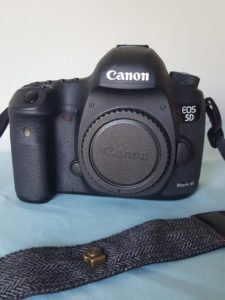
Canon 5D Mark III
Lenses
Prime lenses
- Sigma 50mm 1.4 Art – A 50mm lens is a must for portrait photographers in my opinion. It’s a great “middle ground” lens that can be useful in all situations. I recently replaced my Canon 50mm 1.2 L (listed below) with the Sigma competitor. A gear expert talked up the sharpness of the Sigma version, and he was absolutely right! The best part is, the Sigma is also cheaper than the 50mm 1.2. It’s a win-win! Be sure to purchase the correct mount for Sigma lenses since they make versions for both Canon and Nikon!
- Canon 50mm 1.2 L – This is my most widely used lens as a portrait photographer. The 1.2 f/stop allows me to get beautiful, blurred backgrounds and shoot in very dark reception venues. The fixed focal length allows for razor-sharp photos, and the 50 proves to be sufficient for a “zoom” length in most scenarios. I use this lens for 90% of my senior portraits or bride & groom portraits, so check out Eryn’s senior session blog post to see examples of photos taken with the Canon 50mm 1.2!
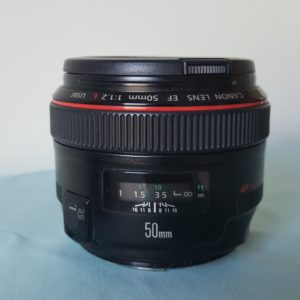
Canon 50mm 1.2 lens
- Sigma 35mm 1.4 L – Sigma lenses are less expensive than the “name brand” Canons, but they pack just as much of a punch! The Sigma 35mm is a favorite of portrait photographers and works well for situations where I need to zoom out more, like shooting “getting ready shots” in hotel rooms or the full family photo at weddings. My 35mm is also the only lens I bring when I travel so I can get those nice wide landscape shots. To check out photos taken with a the Sigma 35mm, see my Iceland travel blog post!
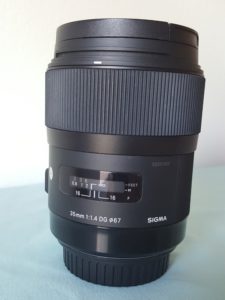
Sigma 35mm lens
- Canon 85mm 1.8 L – The 85mm can be a love/hate for photographers. It creates a beautiful, blurred background due to its high compression, but the 85mm length makes it appear more zoomed in naturally. This can be tricky if you are somewhere where you can’t back up much. My 85mm is the most inexpensive lens in my bag, and I use it the least of my prime lenses. However, the zoom and crisp, sharp images make it a perfect fit for close ups. This is the only lens I use for head shots.
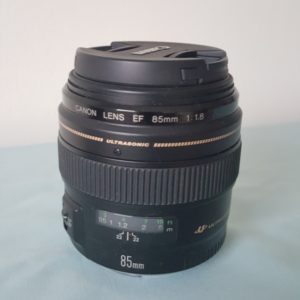
Canon 85mm 1.8 lens
Zoom lenses
- Canon 24-70mm 2.8 L – This is becoming one of my new favorite lenses for weddings. I love it so much that I don’t even use my 35 mm during wedding days anymore! The 24mm focal length allows me to get great shots even in tight indoor spaces. Also, the zoom gives me flexibility to quickly adapt during fleeting moments. This is also the perfect lens for travel because the 24mm length is great for getting wide shots indoors and the zoom adds flexibility so you can get away with only bringing one lens.
- Canon 70-200mm 4.0 L – The Canon 70-200mm 4.0 is the cheaper version of the highly expensive, well-loved 70-200mm 2.8 lens. The budget-friendly option sacrifices the low f/stop, so the lowest aperture on this lens is 4.0. I do not tend to use this lens much for two reasons:
- I take 90% of my photos at an f/stop of 2.2 or lower. Therefore, the 4.0 minimum aperture tends to make my photos look inconsistent with the others I capture.
- Prime lenses (fixed focal length), in my experience, take sharper photos. My photos with a zoom camera are sometimes blurred due to my unsteady hands.
Regardless, this is a great lens option if you are interested in sports or nature photography where you want a more sharp, defined look and higher aperture settings. - Look at the picture of this lens below. This sucker is heavy! So I keep it in my bag unless I absolutely need it.
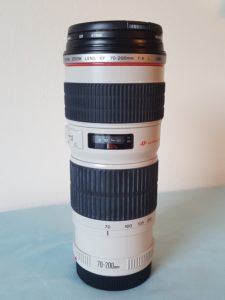
Canon 7-200mm 4.0 lens
Conclusions
First things first, think hard about what you will use your camera for. Contrary to what most people think, the lens matters much more than the camera itself when it comes to photography. Therefore, I highly recommend you buy a camera body on its own and purchase separate lenses optimized for what you shoot. While a kit lens (the lens that comes standard with a camera body) may seem like a natural choice, they tend to be cheap generic lenses with middle-of-the-road aperture and zoom capabilities. Instead, invest in one solid lens that will really serve you. For me, this is my 50mm.
If you have any questions, please feel free to email me at rachelgraffphotography@gmail.com!
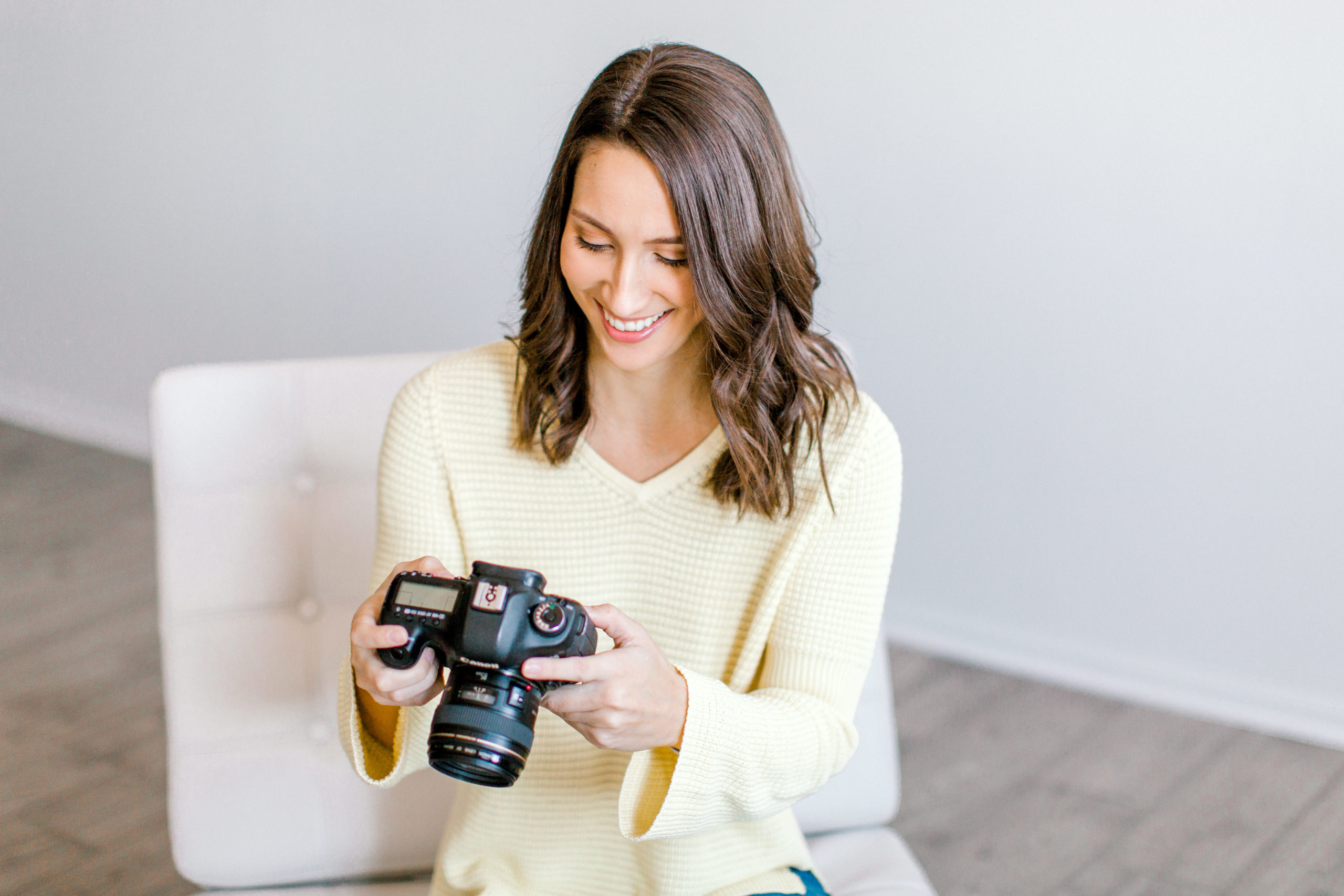
leave a comment